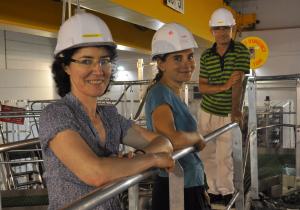Turbulent behaviour under radar scrutiny
2 Jul 2010
-
Robert Arnoux
The DREVE team atop Tore Supra: Pascale Hennequin (LPP), Laure Vermare (LPP) and Jean-Claude Giacalone (IRFM). A fourth member, Roland Sabot, was absent on the day the picture was taken.
Fusion plasmas are turbulent. They develop a large variety of instabilities and fluctuations that drain energy out of their core and reduce the overall performance of fusion devices.
The physics that drive turbulent phenomena are now well identified. Finding means to mitigate their consequences however, remains extremely difficult. Detailed measurements of turbulence are in high demand within the fusion community, as they hold the keys to predicting and controlling the quality of fusion plasma confinement in future tokamaks.
Fluctuations and dynamics in a fusion plasma can be probed by way of microwave radar beams, a technique referred to as "doppler reflectometry" that is routinely implemented in tokamaks around the world, among them DIII-D, Asdex Upgrade and, next door to ITER, Tore Supra.
At Tore Supra, collaboration between the Plasma Physics Laboratory (LPP) at the École Polytechnique in Paris and CEA-Cadarache's Institute for Magnetic Fusion Research (IRFM) has led to the development of a reflectometry system called DIFDOP (doppler diffusion) that has been operated extensively since 2003.
By "shooting" microwave beams from different angles, DIFDOP gives access to different sizes of turbulences. Tore Supra's long discharges provide several seconds of "stationary plasma"—a time long enough for operators to perform up to 200 measurements.
"Observing the density fluctuations within the plasma and the dynamics of turbulences at different scales helps us understand how energy is transferred between these different scales," says Laure Vermare, a physicist at École Polytechnique and a member of the LPP-IRFM collaboration. "This understanding will prove very useful in predicting what will happen in ITER."
DIFDOP has also yielded precious information about the rotating speed of the plasma, a yet little-understood phenomenon that has a stabilizing effect on plasma turbulence as well as on the repartition of the energy fluctuations over the different spatial scales.
Recently, EFDA issued a call for the development of new, powerful tools to study one specific behaviour of fusion plasma turbulence, possibly linked to an improvement of the plasma confinement. LPP and IRFM answered with a joint proposal to develop an additional diagnostic system, also based on doppler reflectometry and backscattering.
Recently, EFDA issued a call for the development of new, powerful tools to study one specific behaviour of fusion plasma turbulence, possibly linked to an improvement of the plasma confinement. LPP and IRFM answered with a joint proposal to develop an additional diagnostic system, also based on doppler reflectometry and backscattering.
This vertical reflectometry diagnostic (DREVE) was installed at Tore Supra in March 2010. When the installation resumes operation in October, DREVE's data will be combined with that of DIFDOP to provide a much clearer picture of the movements inside Tore Supra's plasmas and, by extension, inside fusion plasmas in general.
Having one eye (DIFDOP) that looks into the equatorial plane of the plasma and another one (DREVE) that peers "from above" in the toroidal direction should provided physicists with a treasure trove of information.
"Recent observations on the TJ-II Tokamak, in Spain," says Laure Vermare, "suggest that a form of organization of the turbulence occurs in the transition to the H-Mode. How this transition takes place is still a bit of a mystery. What we are doing here, on a machine that does not operate in H-Mode, is testing new tools that will help us understand this crucial transition."
The H-mode, said its "discoverer" Fritz Wagner in an interview with Newsline last year, is what "makes the goals of fusion possible." Hence the importance of unveiling its secrets ...


